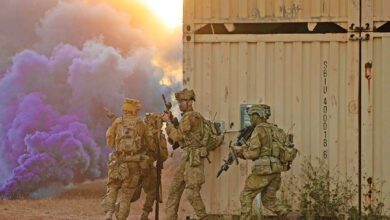India’s Aspirations, Concerns and Interests Meet China’s Policy Positions

There were only two visits between Indian and Chinese heads of government during 2016 — both for multilateral meetings with brief sideline bilateral interactions. Indian Prime Minister Narendra Modi traveled to Hangzhou for the G20 Summit in early September, and Chinese President Xi Jinping visited Goa in mid-October to attend the eighth Brazil, Russia, India, China and South Africa (BRICS) Summit.
However, Indian President Pranab Mukherjee did make a state visit to China, focusing on the mutually declared “Closer Development Partnership” earlier in May 2016. It was his first visit since taking office in July 2012 and the first visit by an Indian president since 2000.
Overall, India-China relations during 2016 were hobbled by specific disagreements that also reflected more fundamental divergences. China’s policy positions on placing a well-known militant leader on a United Nations terrorism list, India’s entry into the Nuclear Suppliers Group (NSG), as well as border and trade differences were interpreted in India as examples of insufficient Chinese regard for India’s aspirations, concerns and strategic interests. Prime Minister Modi linked bilateral relations and broader constraints during his September 2016 visit to China, saying, “To ensure durable bilateral ties and their steady development, it is of paramount importance that we respect each other’s aspirations, concerns and strategic interests.”
In another formulation, Modi called for both countries to “be sensitive to each other’s strategic interests … promote positive convergences … and prevent the growth of negative perceptions.” Clearly, he did not think China was doing its part, but claimed India was doing its part through the Closer Developmental Partnership and cited “maintaining peace and tranquility on the border” and increasing cultural and people-to-people ties as specific successes.

[REUTERS]
In a bizarre and still unclear development soon afterward, Uighur dissident Dolkun Isa, executive committee chairman of the World Uighur Congress, was reportedly given an Indian visa to attend a conference in Dharamsala, only to have it retracted, according to news reports. India’s lively media covered the issues repeatedly throughout the year; Indian officials were muted but clear about the continuing disagreement.
For example, when asked at a news conference about the issue on the eve of Indian President Pranab Mukherjee’s visit to China in May 2016, a Ministry of External Affairs (MEA) official said: “Look on the issue of Jaish-e-Mohammed, I totally agree with what the Chinese government has said that they are in close communication with the Indian side, and we are in close communication with the Chinese side.”
That was the full extent of the official explanation. During Modi’s September 2016 visit to China, Indian officials said he condemned a recent terrorist attack on the Chinese Embassy in Bishkek, Kyrgyz Republic, and reiterated to Xi “that our response to terrorism must not be motivated by political considerations.” Indian briefers did not indicate whether Xi responded.
Indian Foreign Secretary S. Jaishankar was slightly less constrained than his boss, but still careful at a joint meeting of Indian and Chinese think tanks in December 2016. He noted that both countries “face threats from fundamentalist terrorism. Yet, we do not seem to be able to cooperate as effectively as we should in some critical international forums dealing with this subject. Even on sovereignty, surely there can be more sensitivity and understanding.”
The latter sentence appears to reflect the Indian interpretation that China’s reticence about supporting the terrorist designation for Azhar stems from China’s concerns about state sovereignty. This may well be so, but what the incident signifies is that even on an issue where China and India are said to share an interest and principle (anti-terrorism), differences regarding Pakistan and U.N. action trumped the ability and willingness to fully accept the other’s interests and positions.
Nevertheless, the two sides continued to insist that they were cooperating on counterterrorism. In a November 2016 meeting with Meng Jianzhu, secretary of the Central Political and Legal Affairs Commission of the Communist Party of China, Modi said that “terrorism poses the gravest threat to international peace and security, and welcomed increased cooperation between India and China on counterterrorism related matters.”
Another incident complicating India-China relations over the latter half of 2016 was India’s bid for membership in the NSG. Prior to a plenary meeting of the NSG in June in South Korea, China’s Foreign Ministry issued an online statement that noted “large differences” remain among NSG members over including non-Nuclear Nonproliferation Treaty (NPT) signatory countries. India dispatched Foreign Secretary Jaishankar to Beijing for talks June 16-17, 2016. According to the Chinese press briefing: “During this visit, the Indian side expressed its desire of joining the NSG for the purpose of developing nuclear energy to combat climate change. The Chinese side understood India’s need to develop nuclear energy.
Meanwhile, China reaffirmed the importance of the NPT as the cornerstone of the international nonproliferation regime, stressing that the group remained divided on the accession of non-NPT countries. China also noted that “NSG meetings have never put the accession of any specific non-NPT countries on their agenda. The upcoming NSG plenary meeting in Seoul will not cover this issue either. Therefore there is no point talking about supporting or opposing the entry of a particular non-NPT country at this moment. … China’s stance does not target any particular country, but applies to all non-NPT countries.”
India responded later in the year, expressing frustration that shared principles were not being translated into convergent policies. Foreign Secretary Jaishankar said, “Given our Closer Development Partnership and commitment to the [Brazil, South Africa, India and China] group on climate change, we should be supporting each other on implementation of our Paris Agreement commitments.”
In India’s case, predictable access to civilian nuclear energy technology is key. The broad basing of the nuclear technology control group is also helpful to a more representative international order. Keeping in mind this solidarity of major developing states, it is important that China view this as a developmental aspiration and not give it a political coloring.
India’s interpretation of China’s position regarding India’s NSG membership drive was clearly much broader than Beijing’s focus on uniform criteria for membership. This was echoed in other divergences regarding “international order.”
Foreign Secretary Jaishankar highlighted another gap saying, “And for all the talk of China and India sharing interests in global forums despite bilateral differences, ongoing differences are quite stark. Though we have a commitment to a more democratic world order, our actions in respect of the reform of the U.N. Security Council are in contrast to our approaches to usher in a more equitable international economic order through reform of the existing multilateral institutions and our cooperation in creating new institutions such as the Asian Infrastructure Investment Bank and the New Development Bank, formerly the BRICS Development Bank.”
These situations are paradoxical because we actually hardly differ when it comes to principles. Ironically, given the above differences during the year, the nearly six-decades-old border dispute was quiescent in 2016, with only the usual military meetings and special representatives talks taking place.
Speaking to a joint think tank forum in December 2016, Jaishankar focused on the positive, saying the two sides “have generally established peace and tranquility while agreeing on political parameters and guiding principles for a boundary settlement.” He said that ongoing incidents “emanate from different logistical capabilities and a lack of commonly agreed line of actual control” but intriguingly expressed the hope that “as these gaps narrow (presumably referring both to the asymmetry of capabilities and the lack of a shared view of the Line of Actual Control, or LAC), we will see a greater stability that would be helpful toward arriving at a final boundary solution.”
The subtle wording seemed to combine a warning and signaling about India’s efforts to reduce the logistical capability problems on its side of the LAC in Arunachal Pradesh through infrastructure and military upgrades with a reference to India’s consistent diplomatic request for clarification of the LAC — an “ask” that Modi had made during his May 2015 visit to China.
Trade and investment relations were mixed. According to MEA officials, Modi in September 2016 did not cite commercial relations as a positive factor in the relationship — and it is not clear whether he brought them up at all. This was in contrast to Mukherjee’s May 2016 visit, which purposefully kicked off in Guangzhou with its U.S. $1 trillion provincial economy, and during which the president noted that bilateral trade had risen since 2000 from U.S. $2.91 billion to U.S. $71 billion in 2015 despite a trade imbalance, and hoped for “expanding our commerce to make it more equitable” including a greater market for Indian products in China.
Mukherjee also noted as “a matter of satisfaction that there is emerging focus on two-way investment flows.” Jaishankar echoed these sentiments later in the year, saying, “Again, it is not altogether surprising that economic differentials and systemic characteristics created over time pose some significant trade challenges.” He worried that “the growing deficit legitimately raised questions about the sustainability of the current way of commerce.” He ended on a mostly upbeat note, saying, “But it is a testament to our maturity that we have sincerely tried to address this problem through greater investment and wider market access, the former more successfully than I must confess the latter, so far.”
Dr. Satu Limaye is director of the East-West Center in Washington, D.C., and senior advisor at the Center for Naval Analyses. This is excerpted from his article, “India-East Asia Relations: Robust but not Riveting,” and was edited to fit this format. The original article was published in January 2017 in the online publication Comparative Connections, Volume 18, Issue 3.




